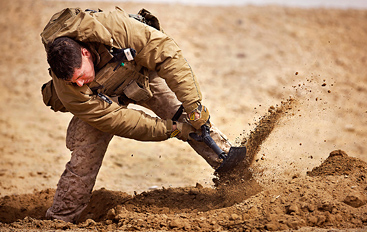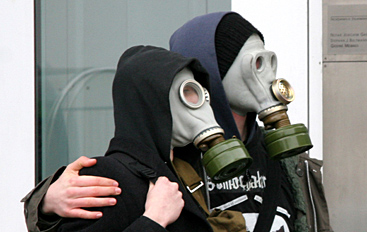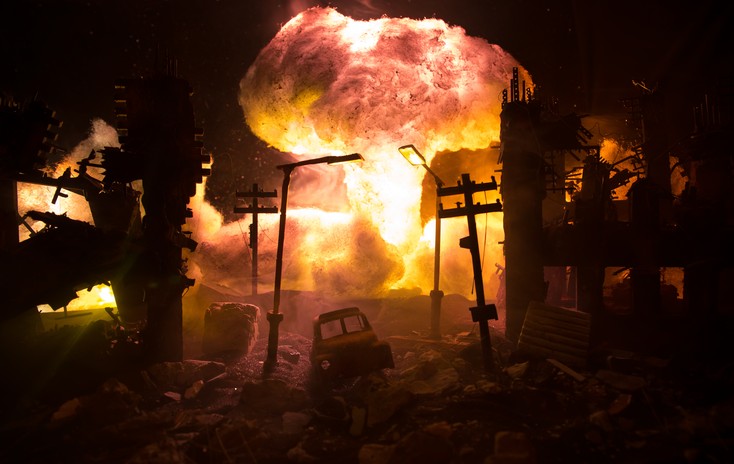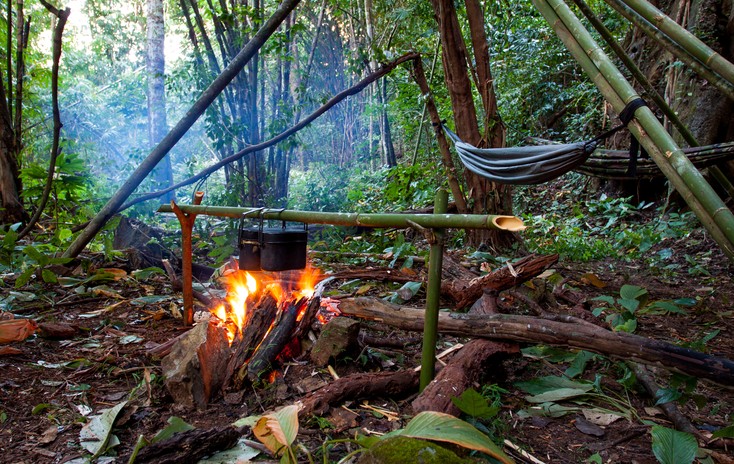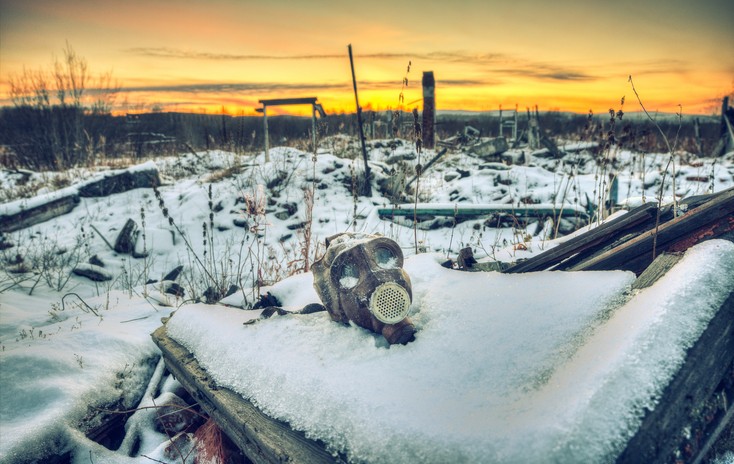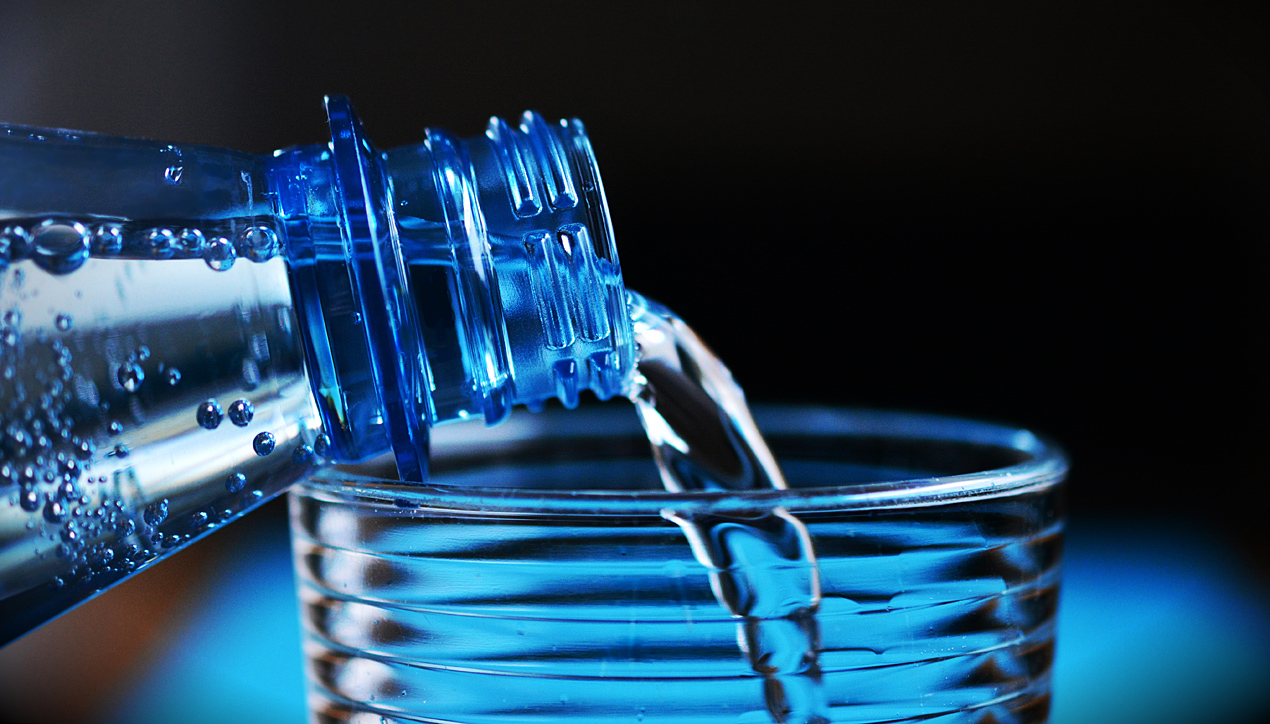
How Much Water Would You Have If the Taps Ran Dry?
No civilisation lasts forever. At some point, the mains water supply that the modern world is used to has to go down, permanently. Even if you're not a prepper it's still a question of when, not if. Of course preppers consider this a realistic possiblilty within their own lifetime, or perhaps within their children's lifetime. Soon enough to give it some serious consideration.
Anyone Can Store Water
Assuming you're not homeless, anyone in a modern Western country can easily store some water. (And even if you are homeless it may be possible to hide or "cache" water somewhere, depending on your circumstances).
Most people can live for a week without food no problem at all (I've fasted on juices and water for as long as 10 days). It would take 2-3 weeks without food before you ran into real problems (and perhaps even longer depending on your constitution). But only 2-3 days without water, (and even less if you're physically active in hot weather) and you'd have a real problem.
One of the more likely scenarios that could end modern civilisation as we know it is a nuclear EMP attack. Which would bring the electricity grid — and therefore the electrically-pumped mains water supply — to a sudden and permanent end. Sudden like less than a minute for the electrical grid, and however long it takes your taps to run dry with no mains pressure for your tap water supply. In any rapid collapse situation such as this, how much water would you have available? For drinking — and for the many other uses of water?
Because water is so easy to store and so vital to human life, this makes it an ideal place to begin with prepping. It may not be as exciting (for some people) as a $200 survival knife, or even as interesting as a $100 first-aid kit but, but it's more essential and easier to obtain. And you can still get those other more interesting items (whatever they may be for you personally) later on...
On this page I'll outline several different ways that people living average lives in modern civilisation can store water for emergency use (i.e. for when there is limited or no water available from the usual sources, such as the taps in your house).
(The rest of this page is coming soon...) This page will begin as a rough outline and then gradually expand over time...
Buying Bottled and Cask Water
Perhaps the easiest way to begin is just to buy some bottles and/or casks of plain (or mineral) water from the shops (e.g. your local supermarket). And throw them in a cupboard somewhere. Or under your bed. Or in the garage. Or anywhere.
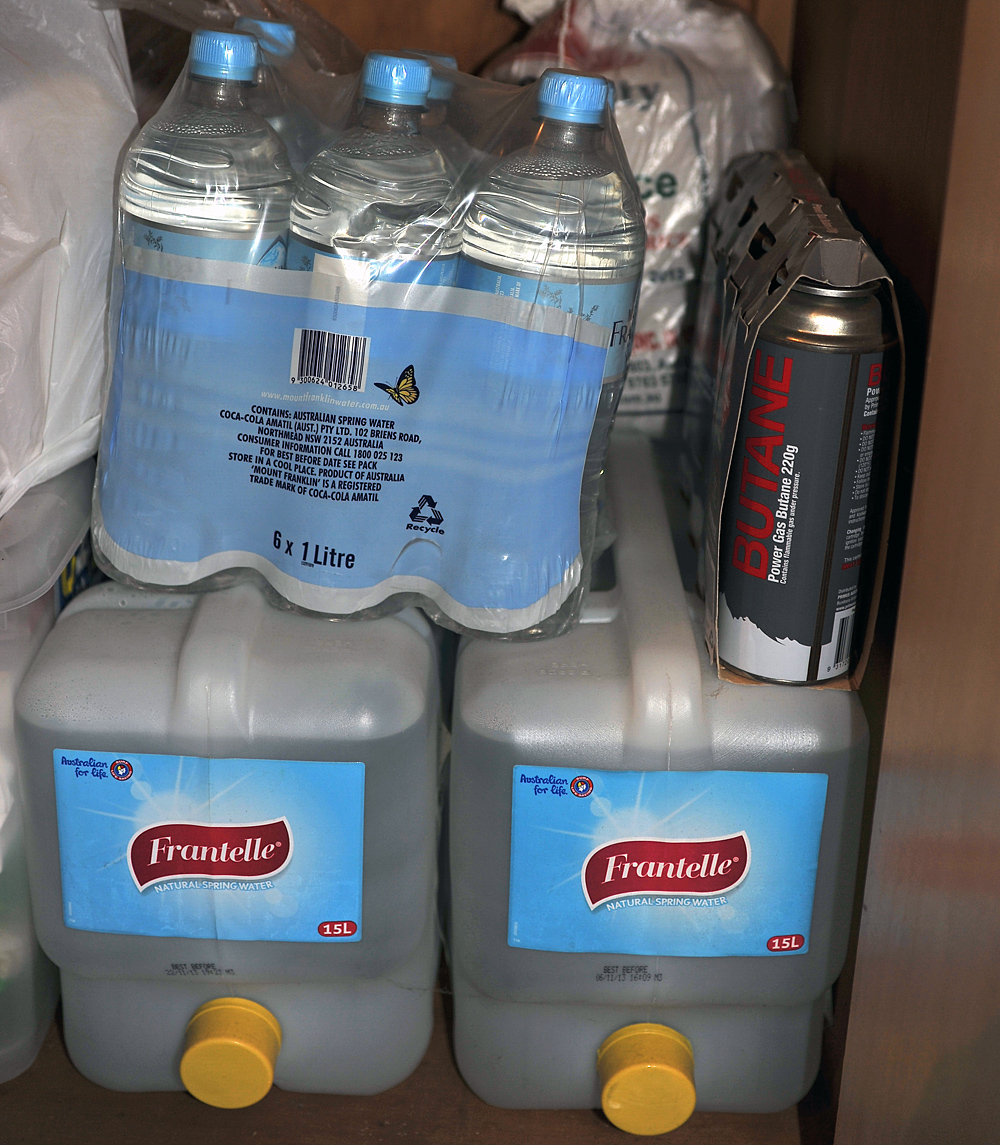
It doesn't cost very much to ensure you've got at least a week or two of drinking water in an emergency. The butane can fuel a cheap camping stove, and then you can even cook.
There will be a use-by or "best before" date on them, though they will probably last a lot longer than that and still be drinkable.
After being in storage a long time (perhaps a couple of years or more, I'll look this up in more detail to find some more precise timeframes) you'd also want to disinfect your stored water before consuming it. There are many ways this can be done (see further down on this page).
Eventually the water will probably absorb a tiny amount of plastic from the containers, but if you one day have no other water available, that's the least of your worries.
Don't Throw Out Those Juice Bottles
You can wash up bottles of juice, soft drink, etc., and fill them with tap water and store them.
They will keep much longer without bacterial growth if you add some disinfecting agent (e.g. a few drops of plain chlorine bleach, or perhaps a solution of iodine). See further down this page for information on disinfecting agents.
You could also use milk containers (ones with proper lids, not cardboard cartons that don't seal, unless perhaps a crisis is imminent and you want to have the most water you possibly can and you don't have much else to use). With milk containers you'd want to be extra thorough with washing them up, and adding disinfectant.
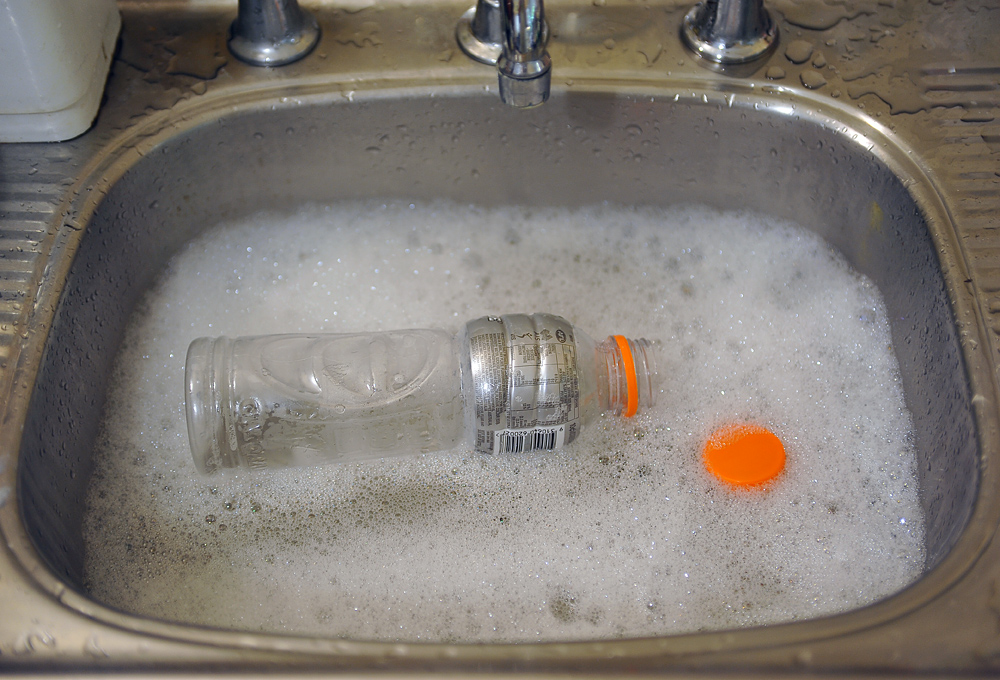
If you save all the bottles like this that you use, wash them up, refill them, and add a small amount of disinfecting agent, you'll end up with a very useful supply of emergency water.
One you get used to doing this it may even be an easier method than buying new, full, bottles and/or casks of water from a supermarket.
Indoor Water Tanks
If you don't own your home or if you live in a flat/apartment, don't think that you can't have your own water tank. You can buy small water tanks from some hardware stores (e.g. Bunnings) with capacity in the ~200 litre range, which can be easily lifted by one person (when empty) and transported in an ordinary car.
I bought one of these and found the very basic tap that it came with leaked, so I fitted a much better tap to it and it's really good now. The tank itself is not that strong, so a powerful sideways impact to the tap would probably tear the side of the tank off. The tap may have to be reinforced somehow, depending on the use (e.g. if using outside with a garden hose attached that might get pulled sideways forcefully).
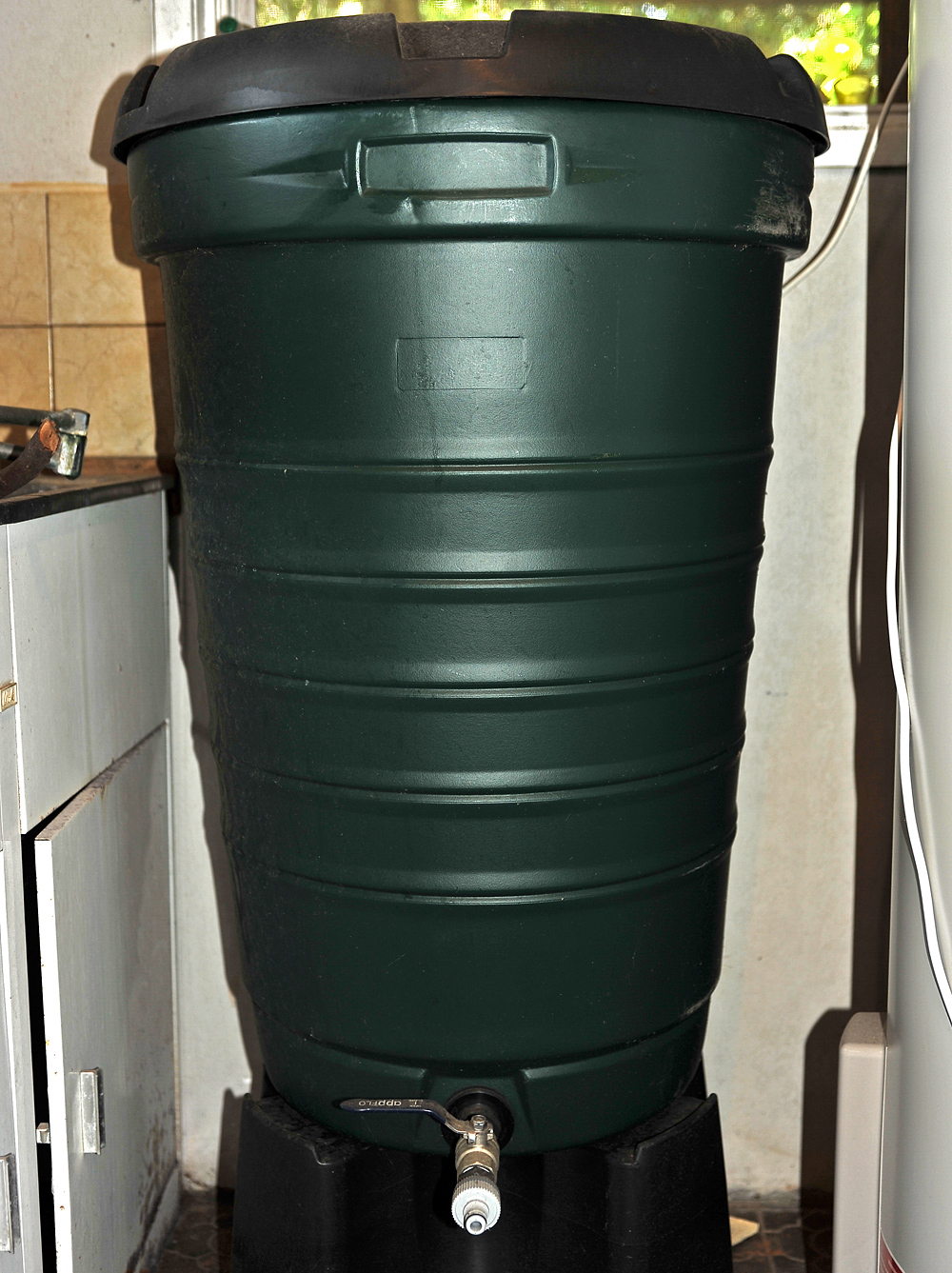
These small, cheap water tanks can be used indoors or outdoors. When empty they are easily carried by one person, and can be transported in an ordinary car.
The black plastic stand that it's sitting on was purchased as an optional accessory, but is a good idea because the tank rests well on it, and having the tank bottom raised off the ground makes it easier to get water from the tap.
These are especially good if you want to hide your preps from view from outside your home, as they can be kept indoors. They can also be kept outside and connected to a downpipe or other method of filling them up from rainwater, like you could with larger tanks.
IBC Tanks
The cheapest way to store water (that I'm aware of) in terms of number of litres per cost of tank is what's known as an "IBC tank". IBC stands for Intermediate Bulk Container. (Wikipedia link here). They are used for the commercial transport of liquids, and generally only used once. Which means there are a lot of used ones available cheaply. Like perhaps $150 AUD for a 1000 or 1200 litre size one. Some are "food grade" and this is the kind you want — you don't want one which has had something toxic in it previously.
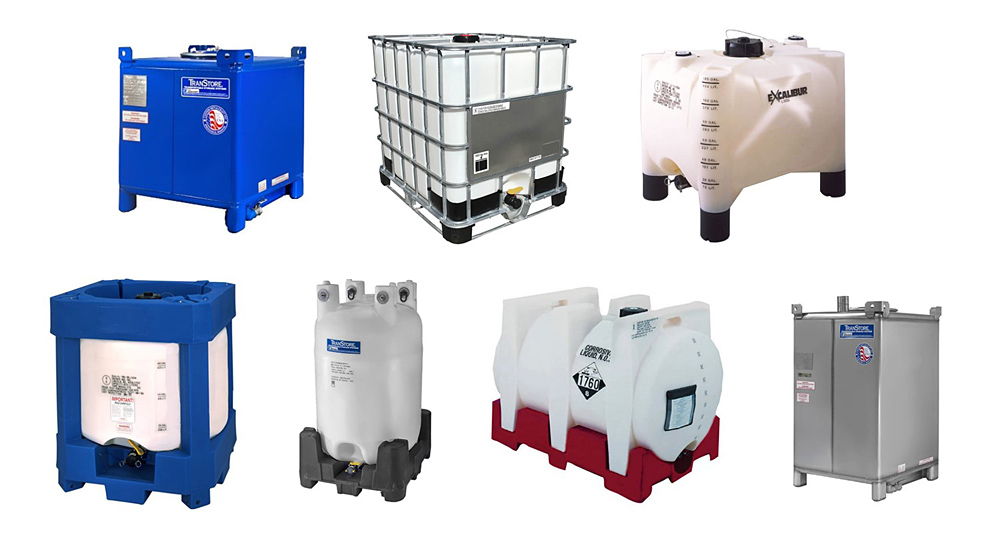
Various types of IBC tanks. The ones I've seen (and which I believe are most used by preppers) are the type in the middle of the top row. The metal frame comes with the tank. Photo by A. S. Eccles/Wikipedia.
The type in the middle of the top row above is the type you usually see. I believe (I'll confirm this later) they are strong enough to be stacked two tanks high (i.e. one tank on top of one other tank) when full.
Many of them are white plastic, which is translucent (i.e. light can pass through it). If you keep these outside in sunlight, some sun will penetrate into the water and this can cause algae to grow. Especially when used for plain water (like rainwater) with no additives (like chlorine). To eliminate this problem they can be painted with a dark coloured, opaque paint. I've got a couple are unpainted and that have been kept in almost complete shade for a few years, and I've had no problem with algae growing inside them so far.
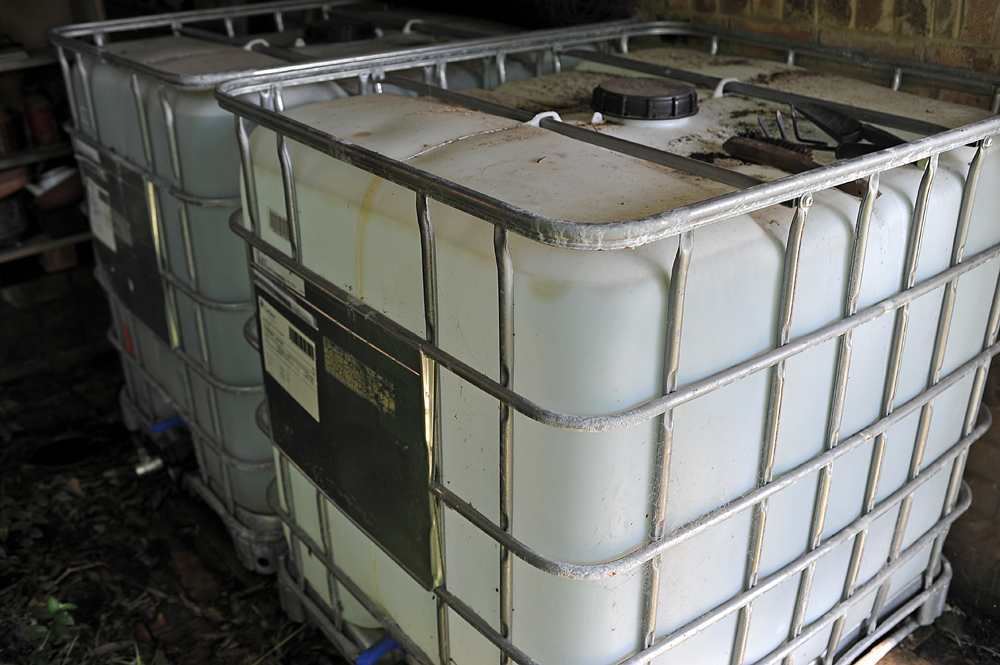
If you're on a tight budget, food-grade IBC tanks like these are probably the best way there is to store a large amount of water.
The tanks above cost a bit over $200 AUD each including delivery and the thread adapter and metal tap (as discussed below). The thread adapters and metal taps were purchased separately. I think the tanks alone were about $140 each delivered. Which means that the thread adapters and metal taps were about 1/3 of the total cost. That was a few years ago, I haven't checked prices more recently than that. Each tank holds about 1,200 litres from memory.
Two adults can carry an empty one, and one adult can drag an empty one around and probably wheel it on a trolley. Water weighs one kilogram per litre so a full one would weigh about 1200 kg plus a bit more for the weight of the tank (something like 50 kg). So you would want to place it on a strong enough surface to hold that much weight.
They were advertised as previously containing a safe food additive of some kind, and that there would still be some residue of that in them. I'll have a look later and see if it's still written on the label. When I got them, some of it was still in there. It was clear and kind of gooey/sticky. I dragged them onto my back lawn and flushed them out with a garden hose. I was assuming the food additive was "safe" and edible by humans, so I didn't think twice about draining them onto the grass. However whatever was in there killed a small patch of grass, which turned brown, and took a while to grow back to fully green again. It took some time with the hose and a mop to scrub out the inside before I was happy with how clean they were. The hole on the top (in the middle, with the black screw-on lid) is large enough to stick your arm in, and also to stick a mop in, so there's not many places inside it that can't be reached with a cleaning implement one way or another.
IBC tanks come pre-fitted with a built-in tap. However the taps they come with are large, clumsy, and very basic. More like a valve (or "door" even) than a proper tap. They're really only designed to be single-use tanks. I doubt the built-in taps would last a long time without eventually starting to leak/drip if they were used on a regular basis (like you'd use your kitchen sink tap). So if you want to use an IBC tank as a regular water supply, it's a very good idea to add another tap. You don't need to remove the original tap, you can add the new tap after it.
The pipe after the built-in tap is threaded with a fairly unique/unusual (and coarse) thread. The one part that's hardest to source (harder than the tanks themselves most likely) is a thread adapter which screws onto the IBC tank outlet, and has a standard/common type of thread often used in plumbing on the other end. These cost about $30-40 AUD and can be found from some specialised water/irrigation supply outlets. Like the kind of people who would sell water tanks, pumps, piping, and other parts for them.
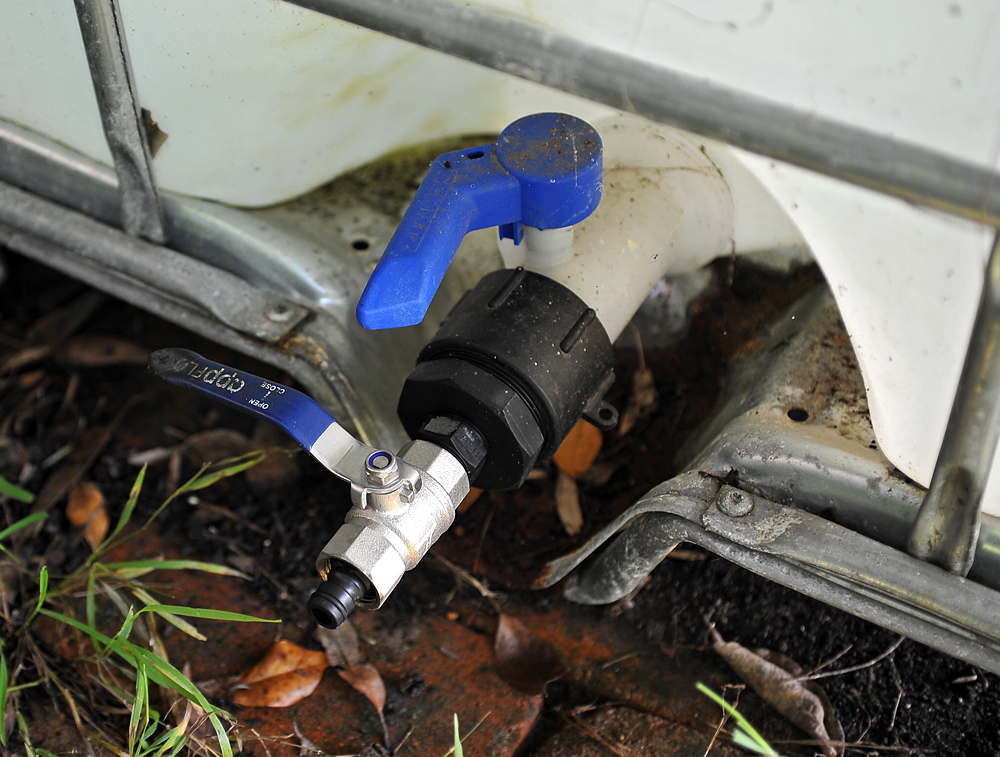
The large blue plastic tap at the top of the photo comes with the IBC tank but is only very basic. The black fittings under that are thread adapters. The first, and largest, adapter is the hardest to find.
The thread adapter converts the unusual IBC tank outlet thread to a standard thread that's common in the plumbing industry. After that, you can see two more black plastic adapters. One to convert the large thread on the outside of the IBC thread adapter to a smaller female thread. The final black plastic one is a male-to-male adapter so that the female thread of the metal tap can fit onto it. At the other end of the metal tap is another black plastic fitting, to attach a standard garden hose.
These same adapters can be used to connect the IBC tank outlet to other things like pipes or hoses, etc. If you have more than one IBC tank, ideally you want one thread adapter per tank — but if on a super-tight budget you could perhaps get away with only buying one, and then have it screwed into the tank that you're currently getting using for your water supply, and then swap it over to another tank if/when that tank is empty. As long as the built-in taps on the other tanks were still sealing well enough to not let your precious water slowly drip away.
Unless you lived in an area of very low rainfall, even just one of these tanks connected to a downpipe (to collect rainwater from your roof) would be enough to keep you in water permanently, provided you were very minimal with water use (like drinking and cooking and basic sanitation).
To use the large amounts of water we're used to in modern society (including showering and flush toilets, laundry, and a bit of watering garden plants, the Australian Government recommends between 5,000 and 20,000 litres. And more than that, just to be sure, if you live anywhere where it might not rain for a while. But modern living uses much more water than you need to stay alive and to perform basic cooking and sanitation. When I lived entirely on tank water at a friends house, I think we had 50,000 litres. And he had only ever run out once or twice in droughts (and had to purchase water that was delivered by truck). And he wasn't shy about using lots of water for non-essential purposes (like keeping the large lawn area green, and using the spa).
Outdoor Water Tanks
Most people already know that you can buy water tanks from professional tank suppliers. This is the best thing to do, if you possibly can. Like if you own the property and can afford one (or more), or can convince your landlord to get one. Even if you have one or more outdoor tanks, it still wouldn't hurt to have some of the other options mentioned on this page such as bottles of water (which could be transported quickly in a future crisis if that became necessary).
Also consider that in a grid-down situation you may need tools (like a spanner, or something, as a minimum) to disconnect your tank outlet from the plumbing if it's connected to a pump that no longer works because there isn't any electricity supply. In this case it would also be very good to have a tap (or piping, or something) which you can screw onto the tank outlet instead of the pump.
Refer to the end of the previous section on IBC tanks for comments on how many litres you need for various types of water use. Also refer to this Australian Government page.
Water from your Hot Water Heater
This is a prepping website, so it doesn't hurt to use intense descriptions sometimes: Consider the large number of Australians who live in cities and suburbs, and have no water tanks nor swimming pools. And no easy access to safely drinkable water found in the wild (like from a river or lake or something). Now consider how many of those households have storage-tank hot water heaters. (It would be interesting to know the actual numbers here.) Now, consider how many litres of drinkable fluid most households have on hand at any given time. Including what's in the fridge, the kitchen cupboards, perhaps a water bottle here and there in some people's bags. Perhaps even occasionally a beer fridge in the garage. Add to that approximately 5-10 litres multiplied by the number of toilets in the house that don't get flushed after the mains water turns off.
Now, imagine that a very short-notice, total, permanent, collapse of the grid (as would happen in a surprise nuclear EMP strike, and other possible scenarios) was to happen right now. In this situation there are probably, literally, a few million Australians (and possibly even more than a few) whose water in their hot water heater would suddenly become their single most precious and valuable material posession. Over the whole world there might even be hundreds of millions of people in this situation.
That's quite a strong statement, but I can't right now think of how it couldn't be at least close to being completely true — if not literally completely true. When you think of all the effort (and years of work) the average modern person puts into their superannuation, and saving for new car, and new kitchen, or whatever they're into — and then consider that in the end a few hundred litres of water will be worth more than all of that combined — I think it does put things into a different perspective in terms of priorities. And calls to attention what's really important.
If you have a storage-tank type hot water heater (i.e. one with a tank and not an instantaneous one with no tank), then you have some emergency water available. Depending on the size of your water heater, this will be up to a few hundred litres. Which is probably a lot more than most urban and suburban non-preppers have in their fridge or kitchen cupboards.
Getting the water out can be somewhat of a challenge. There are a great many prepping and survival books that mention this, and a great many pages on the internet that describe it. The problem is that nearly all of them are non-Australian, and they say things like "open the drain valve at the bottom of your hot water heater". That would be great, except that many Australian hot water heaters don't actually have a drain outlet at all. Which, if you were desperate for water, and expecting to be able to "open the drain valve", would be a nasty surprise.
Apparently, in Australia, the manufacturers often don't bother to install a drain valve on many storage-tank hot water heaters. If there's only one hole at the bottom of your tank, and it's connected to your plumbing system, this means you have to somehow disconnect the inlet water pipe (e.g. using a wrench or spanner). How to do this is described in detail here at survival.org.au.
If that fails, you could always saw through the inlet pipe with a hacksaw, or some other saw that can cut metal (assuming you have one), and then have something to plug up the end of the pipe with (unless you want to drain the entire contents of the tank all at once). Most water pipes (proably all modern ones, I think) are made from copper, which is a soft metal. An average person could easily saw through one with a hacksaw in a few minutes or less.
You would definitely want to make sure the water inside the hot water heater isn't too hot before attempting anything like this. And that the electricity (if there still is any) to the water heater is turned off. If the electricity were to come back on with the tank empty, it could potentially damage or destroy the heating element inside the tank.
I just went to look at my own hot water heater. It's a storage-tank type. Thankfully, it does effectively have a separate "drain valve". What it actually has, is a pair of inlet holes and a pair of outlet holes, with each pair 180 degrees around the other side of the tank from the other. Presumably so you can install it either way around, without having to rotate the tank and perhaps run the electrical cable differently to your previous tank. The two holes at the top (one on each side) are labelled "OUTLET" and the two holes at the bottom (again, one on each side) are labelled "INLET". One of each is connected to the plumbing system and the other pair are capped with threaded screw-in brass plugs/caps. The words inlet and outlet are labelled how the pipes are connected for normal use — the cold water goes in at the bottom and the hot water comes out at the top.
While not being a plumber nor really knowing the engineering details, I can think of two reasons why it might be done this way. One is that heat rises so you would want the hot water coming out the top, since it would be hotter that way and the cold water coming in the bottom would stay at the bottom. The other is that if the mains water is turned off (e.g. when they are working on the pipes outside), and if the usual outlet was the bottom of the tank, potentially the whole tank could empty under gravity. Which would then be a problem when the heating element turned on and the tank was empty (I imagine that the element would likely overheat and burn out, unless there is some sort of water level sensor switch in it.)
The important point here is to not be fooled by the labels. The hole at the bottom, which is on my water heater clearly labelled "INLET" is effectively the outlet a.k.a. "drain valve" when you drain the water heater under gravity (with no mains pressure).
It would be very good to have something else to screw into the "INLET" i.e. outlet hole, like a tap, or a thread adapter that you could attach a garden hose to (or ideally both). But if you didn't, it wouldn't be the worst thing ever, since you could just screw back in the brass cap without losing that much spilled water. As a minimum you would need something to unscrew the brass cap with. Like a spanner. A shifter would be fine. Even a pair of pliers would probably work, if big enough, if that was all you had. You would also, most likely, have to allow air to enter the tank from the top for much water to flow out. Just turning on a hot tap somewhere in the house may be enough for this. Or if not I could unscrew the brass cap from the spare hole marked "OUTLET" near the top of the tank. If my tank didn't have one, disconnecting the pipe from near the top of other side of the tank would have the same effect.
Note (for people skim-reading this, who may not have read it from the top) that all of this talk about disconnecting pipes from your water heater, and opening capped holes, is assuming there is no mains water pressure, and that the water in the heater is cold (or at least not very hot), and there is no electricity supply to the water heater.
Swimming Pools
Swimming pools contain a lot of water, and this can be used in some circumstances. I'll add more about this later on... If you've been waiting for years for an excuse to get a swimming pool, this could be it. I haven't looked at the numbers but presumably it would be more expensive than to buy water tanks of the same capacity. It would also be a lot easier to keep water in tanks from going off/stagnant than water in a swimming pool without an operational filter nor regular addition of chemicals. You can't usually swim in water tanks, though.
Disinfecting Agents
I'll expand on this section somewhat eventually...
Betadine: 4-10 drops per litre of water, and wait half an hour for it to kill things in the water. Use less drops (like 4) if you want to conserve your Betadine, and more (like 8-10) if the water is particularly dodgey. You can write the number of drops per litre on the bottle with a fine-tip permanent marker (like a "Sharpie" perhaps).
Its generic name is povidone-iodine. Betadine is 10% povidone-iodine, and povidone-iodine itself contains 10% iodine. Which means that Betadine is 1% actual iodine. (10% of 10% is 1%). This may help if you're looking around the web to consider dose rates.
A minority of people are allergic to iodine and this may be a problem for you. Also if you have overactive thyroid or certain other thyroid issues it's contraindicated (meaning don't use it). It's also contraindicated during pregnancy — but if there's no other water available it would perhaps be a lot better than dying of thirst or even than getting a very severe gastrointestinal infection. It's also advised to only use iodine-purified drinking water for no longer than a few months at a time — but in a real emergency I doubt it would be a severely major issue if you went for a lot longer.
Betadine is very easy to carry around with you, it comes with its own eyedropper, and it keeps for at least a few years. Iodine is a very unstable chemical element, and eventually Betadine will gradually decompose into other things which may or may not work very well for this purpose. I'll do some further research on this, and everything on this website comes with a general disclaimer, but in a real emergency (and without doing any more research than what I already know), I'd rather drink several drops of 10-year old Betadine than drink a few litres of stagnant, bacterially contaminated pond water. Obviously it would be much better to have fresh Betadine, if you have some.
Chlorine Bleach: You want plain ordinary bleach without any fragrances or other weird things added to it. Though I imagine that even a few drops of some nasty chemical scent would be better than dying of thirst or getting a horrible gastro bug, if you didn't have anything else to use on hand. But if you're buying it for prepping (and you should — it's very cheap and useful), buy the plain type. The chlorine gradually evaporates and after many years it will turn into salty water. So ideally you want to buy a new bottle about once a year.
The amount of bleach to use varies between different sources of information (and with the particular brand/concentration of the bleach) but "a few" drops per litre, like 2-5 drops per litre, is usually about right. See here and here. You would want some sort of eyedropper to add this, otherwise measuring individual drops would be difficult. You would also want to wait for a while after adding it, perhaps half an hour, for it to do it's job on the nasties that may be in your water. Once you decide on the exact number of drops per litre for the type of bleach you have, you can write it on the bottle with a permanent marker (like a "Sharpie").
Calcium Hypochlorite: See this page about how to use this. You can buy it in powder form, usually used for swimming pool disinfecting, and apparently it keeps for a very long time in powder form.
Water Purification Tablets: You can buy these from outdoor recreation / camping stores and probably chemists also. They are probably just common chemicals (like chlorine for example, I'll look into this further...) but more expensive, and easier to carry around with you.
Stay Tuned...
The rest of this page is coming soon... Including more methods of purifying water, and small portable water filters you can carry around.
Prelude to Catastrophe The world had been teetering on the edge of conflict for years. Political tensions, economic rivalries, and territorial disputes had escalated, creating a global atmosphere of distrust and fear. Nations fortified their borders...
Surviving the collapse of modern society would require a mix of practical skills, knowledge, and mindset. Here are some of the most important skills: Basic Survival Skills: ...
Nuclear Winter
A nuclear winter is a theoretical scenario that would follow a large-scale nuclear war, characterized by severe and prolonged climatic cooling and other catastrophic environmental effects. Here's what it might be like: ...

 Welcome to Prepping.com.au, the new web magazine.
Welcome to Prepping.com.au, the new web magazine.
 What is Prepping? A guide for normal people to get started.
What is Prepping? A guide for normal people to get started.
 How to use this site. When all else fails, read the instructions.
How to use this site. When all else fails, read the instructions.
 This is your mission, should you choose to accept it.
This is your mission, should you choose to accept it.



